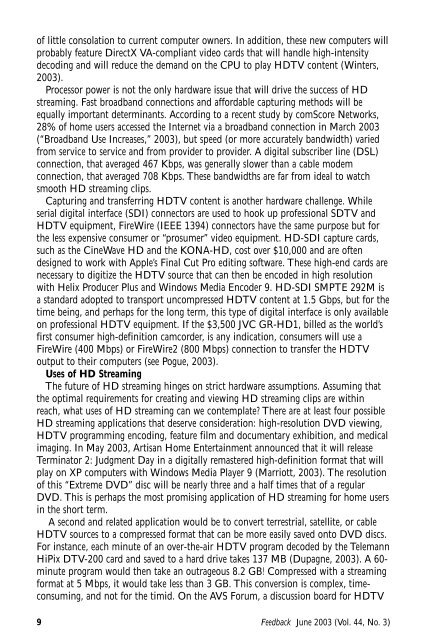JUNEFeedback
Issue 3 - Broadcast Education Association
Issue 3 - Broadcast Education Association
Create successful ePaper yourself
Turn your PDF publications into a flip-book with our unique Google optimized e-Paper software.
of little consolation to current computer owners. In addition, these new computers willprobably feature DirectX VA-compliant video cards that will handle high-intensitydecoding and will reduce the demand on the CPU to play HDTV content (Winters,2003).Processor power is not the only hardware issue that will drive the success of HDstreaming. Fast broadband connections and affordable capturing methods will beequally important determinants. According to a recent study by comScore Networks,28% of home users accessed the Internet via a broadband connection in March 2003(“Broadband Use Increases,” 2003), but speed (or more accurately bandwidth) variedfrom service to service and from provider to provider. A digital subscriber line (DSL)connection, that averaged 467 Kbps, was generally slower than a cable modemconnection, that averaged 708 Kbps. These bandwidths are far from ideal to watchsmooth HD streaming clips.Capturing and transferring HDTV content is another hardware challenge. Whileserial digital interface (SDI) connectors are used to hook up professional SDTV andHDTV equipment, FireWire (IEEE 1394) connectors have the same purpose but forthe less expensive consumer or “prosumer” video equipment. HD-SDI capture cards,such as the CineWave HD and the KONA-HD, cost over $10,000 and are oftendesigned to work with Apple’s Final Cut Pro editing software. These high-end cards arenecessary to digitize the HDTV source that can then be encoded in high resolutionwith Helix Producer Plus and Windows Media Encoder 9. HD-SDI SMPTE 292M isa standard adopted to transport uncompressed HDTV content at 1.5 Gbps, but for thetime being, and perhaps for the long term, this type of digital interface is only availableon professional HDTV equipment. If the $3,500 JVC GR-HD1, billed as the world’sfirst consumer high-definition camcorder, is any indication, consumers will use aFireWire (400 Mbps) or FireWire2 (800 Mbps) connection to transfer the HDTVoutput to their computers (see Pogue, 2003).Uses of HD StreamingThe future of HD streaming hinges on strict hardware assumptions. Assuming thatthe optimal requirements for creating and viewing HD streaming clips are withinreach, what uses of HD streaming can we contemplate? There are at least four possibleHD streaming applications that deserve consideration: high-resolution DVD viewing,HDTV programming encoding, feature film and documentary exhibition, and medicalimaging. In May 2003, Artisan Home Entertainment announced that it will releaseTerminator 2: Judgment Day in a digitally remastered high-definition format that willplay on XP computers with Windows Media Player 9 (Marriott, 2003). The resolutionof this “Extreme DVD” disc will be nearly three and a half times that of a regularDVD. This is perhaps the most promising application of HD streaming for home usersin the short term.A second and related application would be to convert terrestrial, satellite, or cableHDTV sources to a compressed format that can be more easily saved onto DVD discs.For instance, each minute of an over-the-air HDTV program decoded by the TelemannHiPix DTV-200 card and saved to a hard drive takes 137 MB (Dupagne, 2003). A 60-minute program would then take an outrageous 8.2 GB! Compressed with a streamingformat at 5 Mbps, it would take less than 3 GB. This conversion is complex, timeconsuming,and not for the timid. On the AVS Forum, a discussion board for HDTV9Feedback June 2003 (Vol. 44, No. 3)
















